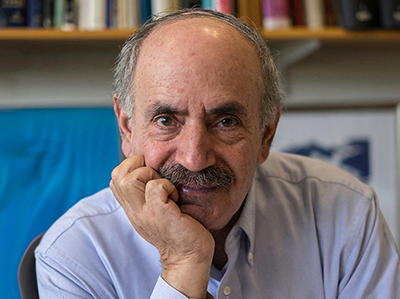
Principal Investigator Robert Weinberg is a Daniel K. Ludwig Professor for Cancer Research.
Research in the Weinberg Laboratory is focused on the mechanisms by which carcinoma cells – mostly breast cancers – generate aggressive tumors and metastatic outgrowths. Specifically, the group is interested in understanding the molecular mechanisms that govern cellular transitions between the more organized, sedentary epithelial state and the more invasive, motile mesenchymal state, and from there the transition to a stem-cell state from which they can become cancer stem cells (CSCs) and drive disease progression.
The epithelial-mesenchymal transition (EMT) is a cellular program that imparts to epithelial cells attributes of aggressive, metastatic cancer cells. The Weinberg group has demonstrated that experimentally activating the previously latent EMT program in otherwise non-metastatic primary tumor cells gives them the ability to disseminate and form hundreds of lung micrometastases, contrasting with comparable cells in which EMT is not activated and micrometastases not detected. Thus, cancer cells that have sustained multiple heritable genetic and epigenetic changes during primary tumor formation do not require additional genetic changes in order to metastasize, since activation of EMT does not involve genetic alterations.
More recently, the group’s experiments have uncovered a group of eight genes whose products are components of multi-subunit chromatin-modifying complexes. Each of the encoded proteins is essential for cells to maintain residence in an epithelial state; they can be considered “guardians of the epithelial cell state.” Current work is examining how such multi-subunit complexes can permit a cell to respond to extracellular signals and trigger activation of an EMT program.
Further, cancer cells that have activated their EMT program can readily enter a stem-cell state and become cancer stem cells (CSCs). The Weinberg Laboratory has previously shown that CSCs, which exhibit a mix of epithelial and mesenchymal characteristics, arise in >100-fold larger numbers once EMT has been activated in non-CSCs. The researchers also showed that more epithelial, non-CSCs may spontaneously enter into the CSC state via activation of their previously latent EMT programs, indicating great plasticity in these cells and bidirectional interconversion between the CSC and non-CSC states. Ongoing research in this area is aimed at better understanding the relationship between specific EMT states and stem-cell state.
Search PubMed for Weinberg Lab publications
Contact Information
Robert Weinberg, PhD
Whitehead Institute
(617) 258-5159
weinberg@wi.mit.edu
Administrative Assistant
Christine Hickey
(617) 258-5158
hickey@wi.mit.edu
